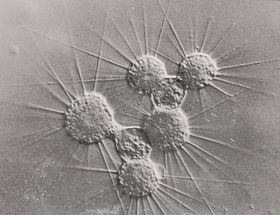Sun animals
The division of living beings into systematics is a continuous subject of research. Different systematic classifications exist side by side and one after the other. The taxon treated here has become obsolete due to new research or is not part of the group systematics presented in the German-language Wikipedia.
The spherical sun animals ( Heliozoa ) are single-celled organisms. They have special pseudopodia ( axopodia ) that radiate out in all directions. The axopodia are not used here for locomotion, but for catching prey and increasing the water resistance in order to slow down sinking.
For a long time the Heliozoa were considered a natural kin, but in the last few decades they have proven to be a polyphyletic , i.e. unnatural, group composed of various kin groups:
The rhizaria include the Desmothoracida (Clathrulinidae) and Heliomonadida , which live in freshwater, as well as the marine Gymnosphaerida and the species Sticholonche zanclea, which today belongs to the Radiolaria (radiation animals) .
The order Centrohelida can not be classified ( incertae sedis ) , and from the group of Chromalveolata the stramenopil family Actinophryidae and some related genera were counted as sun animals.
Actinophrys sol , a representative of the sun animals, was named single cell of the year by the German Society for Protozoology in 2013 .
description
The cytoplasm consists of the outer, roughly vacuolated ectoplasm and the inner, finely vacuolated endoplasm . Shell or skeleton formations, which were important for the systematic classification of the Heliozoa, are very common. In some forms, foreign bodies such as. B. Diatom shells or grains of sand recognizable as shell structures (Acanthocystidea). Other heliozoans, on the other hand, form or build their own shell. The components formed are very diverse, but characteristic of the individual species. So you can find small balls, discs, plates, needles and hollow spikes. The clathrulins, for example, have small grid-shaped pebble shells similar to the radiolarians . Sun animals are almost always freshwater inhabitants. Mostly mesotrophic still waters or slowly flowing ditches with dense vegetation are preferred .
Ingestion
The ingestion of food takes place via the ray-like extensions of their cells, the axopodia , and transport to the center via a granular flow . Both on the cell periphery and in the cortical plasma (inner cell membrane area) of the axopodia there are numerous small, mobile granules called extrusomes . Extrusomes are cell organelles that can release special ingredients in response to certain external stimuli (chemical and physical). These substances cause prey organisms (such as paramecia ) to stick to the sun animal . In order to then wrap around the food, the protoplasm at the tip of the axopodia can lengthen in order to enclose the prey as quickly as possible in a vacuole (phagocytosis). Originally it was believed that if the radial axopodia were touched directly, the prey would be paralyzed or stunned by a toxin. However, this view turned out to be incorrect, because during the entire process of enclosing the prey in the food vacuole, a resistance of the captured ciliates or flagellates can be observed with a light microscope . Every now and then they even manage to tear themselves away again.
The axopodia of sun animals usually appear to be fairly stable in shape and size, but they can also be drawn in - or better: melted down - as required. This happens especially during and after eating. Some heliozoans, such as Actinophrys sol , form so-called feeding communities (commensalism) by fusing with other cells in order to collect larger prey objects. Here, two or more individuals can join together. In this way, sun animals can form large aggregates (colonies) from many individuals. Similar to the amoeba , the prey is enclosed in a large food vacuole and then digested together. After about 24 hours, the individuals separate from each other and everyone "goes" their own way again. Heliozoa feed mainly on other single-celled organisms such as ciliates (ciliates), but occasionally small metazoans (multicellular organisms) as water bears ( tardigrades ) and rotifers ( Rotifera ).
literature
Three books from the time when the Heliozoa were still considered a natural group:
- G. Ehrenberg (1838): The infusion animals as perfect organisms. 2 volumes, Leipzig.
- M. Linnenbach, K. Hausmann, DJ Patterson (1983): Ultrastructural studies on the food vacuole cycle of a heliozoon. Protoplasm 115, 43-51.
- H. Rainer (1968): Urtiere, Protozoa. Rhizopoda. Sun creatures, Heliozoa. In: M. Dahl, F. Peus (Ed.): The animal world of Germany and the adjacent parts of the sea. Part 56. Fischer Verlag, Jena.
Individual evidence
- ↑ Video: Food intake in the sun animal Actinophrys ed. Institute for Scientific Film , doi : 10.3203 / IWF / C-12764
- ↑ Video: Food intake in the sun animal Actinophrys ed. Institute for Scientific Film , doi : 10.3203 / IWF / C-12764 , 00: 05-00: 12 min


